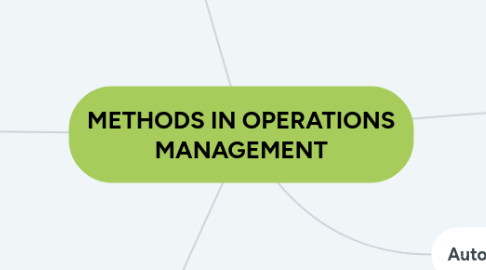
1. MANUFACTURING PROCESS
1.1. Just In Time (JIT)
1.1.1. Reduce costos
1.1.2. Maximiza ganancias
1.2. Kanban Management
1.2.1. Manufacturing Kanban
1.2.2. The mobile Kanban
1.3. Agile Manufacturing System (AMS)
1.3.1. New business cooperation
1.3.2. Large scale of telecommunication infrastructures
1.3.3. Flexible modularized manufacturing system and products.
1.4. Lean Production (LP)
1.4.1. Manufacture low cost
1.4.2. High efficiency
1.4.3. Quality
1.4.4. Customers’ satisfaction
1.5. Flexible Manufacturing System (FMS)
1.5.1. CNC machining equipments
1.5.2. Material storage devices
1.5.3. Computer control system
1.6. Concurrent Engineering (CE)
1.6.1. Product design
2. QUALITY ASSURANCE
2.1. ISO9000
2.1.1. International quality management standards
2.2. Six Sigma Management
2.2.1. Find and eliminate causes of defects and errors
2.2.2. Reduce cycle times and costs of operations
2.2.3. Improve productivity
2.2.4. Customer expectations
2.2.5. Asset utilization
2.2.6. Returns on investment
2.2.7. Service processes
3. OPERATION PHILOSOPHY
3.1. Total Quality Management (TQM)
3.1.1. Quality circle (QC) groups
3.1.2. Benchmarking
3.1.3. Six sigma management
3.1.4. Cycle-time reduction
3.1.5. Continuous improvement
3.2. Theory of Constraints (TOC)
3.2.1. System’s performance is dominated by its constraints
3.2.2. Partial improvement does not mean overall improvement
3.2.3. Performance does not mean people’s nature is bad.
3.3. Pptimized Production Timetable at First (OPT)
3.3.1. Low inventory
3.3.2. Short manufacturing cycle
4. MANUFACTURING SYSTEM
4.1. Material Requirements Planning (MRP)
4.1.1. Demand quantity
4.1.2. Time of dependent materials from final products’
4.2. Closed Loop Material Requirements Planning
4.2.1. Intact production plan
4.2.2. Control system
4.2.3. Rough-cut capacity planning
4.3. Manufacturing Resources Planning (MRPII)
4.3.1. Business planning (BP)
4.3.2. Production plan (PP)
4.3.3. Master production schedule (MPS)
4.3.4. Material requirements planning (MRP)
4.3.5. Production assignment control (PAC)
4.4. Enterprise Resources Planning (ERP)
4.4.1. Customers’demand
4.4.2. Inner resources
4.4.3. Manufacture resources of suppliers
4.4.4. Manufacturing Resource Planning
4.4.5. Logistics
4.4.6. Capital flow
4.5. Supply Chain Management (SCM)
4.5.1. Information flow
4.5.2. Logistics
4.5.3. Capital flow
4.5.4. Value flow
4.5.5. Work flow
4.6. Business Process Reengineering (BPR)
4.6.1. Redesign the processes
